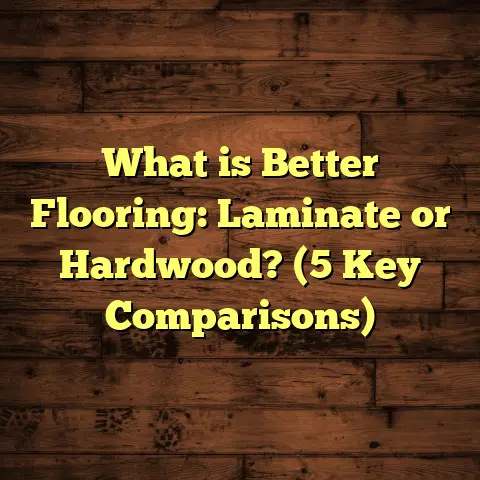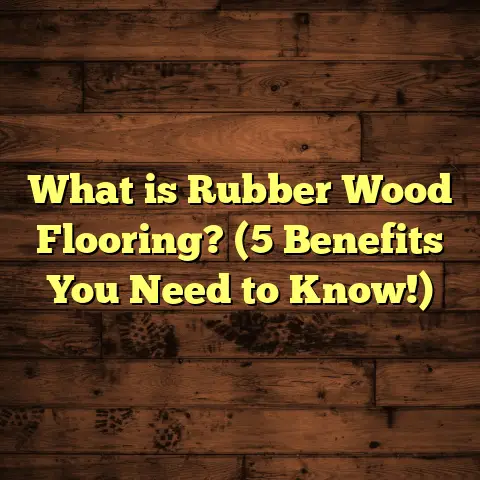What is Better for a Porch Floor: Cedar or Mahogany? (5 Key Factors Revealed)
Have you ever stopped to think about what really makes a porch floor stand out? I mean, beyond just looking nice—what materials actually hold up well against weather, wear, and time? If you’re like me, you want something that not only looks great but lasts without a ton of maintenance. That’s why I’ve spent a lot of time figuring out which wood works best for porch floors, especially between cedar and mahogany. Both are beautiful choices, but which one truly shines when it comes to porch flooring? Let me walk you through what I’ve learned.
What is Porch Flooring Made of? A Quick Look at Cedar and Mahogany
Porch flooring is the surface you step on outside your house—usually exposed to sun, rain, snow, and foot traffic. Because of that exposure, the material needs to handle moisture, temperature swings, and wear while still looking good.
Cedar is a softwood known for its natural resistance to rot and insects. It has a warm, reddish tone with a distinct aroma that many people love. It’s lightweight and relatively easy to work with.
Mahogany, on the other hand, is a hardwood prized for its rich, deep color and fine grain. It’s dense and strong, often used in high-end furniture and outdoor projects because of its durability and elegant appearance.
Both woods are popular for outdoor use, but they perform differently depending on the climate, maintenance, and how you want your porch to look over time.
Cedar: The Softwood With Surprising Strength
I first worked with cedar about a decade ago when a client wanted a cozy porch that blended with their rustic cabin aesthetic. At first glance, cedar seemed like the obvious choice because of its affordability and natural resistance to decay. But what surprised me was how much personality this wood has.
Natural Resistance and Softness
Cedar contains natural oils that repel insects and resist moisture-related decay. That means it can last quite well outdoors without heavy chemical treatments. However, because it’s a softwood, it’s prone to dents and scratches. I remember a porch I built for a family with young kids where the cedar boards quickly showed signs of wear after just one season of active play.
Still, cedar’s softness makes it easy to cut and install—something I’ve appreciated when working under tight timelines or budgets. It’s also lighter than hardwoods like mahogany, which means less strain on porch joists and easier handling.
Weathering Characteristics
One thing I always tell clients about cedar is its aging process. If left untreated or unsealed, cedar tends to fade into a silvery-gray patina over time. Some homeowners love this weathered look—it can give your porch a charming, natural feel that blends well with outdoor landscapes.
But if you prefer your porch to maintain its original warm reddish color, regular sealing or staining is needed. I’ve found that applying a quality sealant every 1-2 years keeps cedar looking vibrant much longer.
Cost Benefits
Cedar is generally more affordable than mahogany. On average, I’ve seen cedar cost about $4 to $7 per square foot for materials alone. Installation costs are usually lower too since it’s easier to work with.
For homeowners on a budget who want decent durability and pleasing aesthetics, cedar is often the go-to choice.
Mahogany: The Hardwood Luxury Choice
About five years ago, I took on a custom-build project for a lakeside home where the client specifically wanted mahogany flooring for their porch. The goal was elegance combined with durability that could withstand the humid conditions near water.
Strength and Durability
Mahogany is one of the densest hardwoods commonly used for outdoor flooring. Its density (about 40-45 lbs/ft³) means it resists dents, scratches, and general wear better than any softwood I’ve worked with—including cedar.
On that lakeside porch project, even after years of exposure to sun, moisture, and frequent foot traffic from family gatherings, the mahogany floor remained mostly unmarred.
Appearance and Aging with Grace
Mahogany’s deep reddish tones create an inviting warmth that feels timeless. Unlike cedar’s natural graying process when untreated, mahogany tends to darken slightly over time but maintains its rich color much longer.
Clients often compliment mahogany floors for their polished look and fine grain texture. The wood works well with both classic and modern design themes.
Installation Considerations
Because mahogany is dense and heavy, installation requires more care. The porch substructure must be strong enough to support the weight. Handling boards is tougher too—they aren’t as forgiving as cedar when cutting or fitting.
From my experience, installing mahogany takes more time and skill but pays off in long-term satisfaction.
Cost Realities
Mahogany is definitely pricier—typically between $10-$15 per square foot just for materials. Labor can also be higher due to complexity.
That said, if you’re planning on staying in your home for many years or want a low-maintenance surface that looks premium, mahogany can be an investment worth making.
5 Key Factors When Choosing Between Cedar and Mahogany for Your Porch Floor
Let’s break down five critical factors that will help you make this decision based on my experiences and research.
1. Durability: How Tough Does Your Porch Flooring Need to Be?
Durability often tops the list for me when advising clients.
- Cedar offers good resistance against rot and insects thanks to its natural oils but is soft enough to dent or scratch easily.
- Mahogany provides superior hardness (Janka hardness rating around 2200 lbf) compared to cedar (around 350 lbf). This makes it much better at standing up to heavy foot traffic or rough conditions.
In one project in a busy household with pets and kids running around constantly, mahogany floors showed minimal damage after three years while cedar floors nearby needed refinishing after only one season.
If your porch faces lots of use or harsher weather—think snow shovels scraping or heavy rain exposure—mahogany will generally outlast cedar by years.
2. Maintenance: How Much Effort Do You Want to Put In?
I hear this question all the time: “How often will I need to seal or refinish?”
Here’s what I’ve learned:
- Cedar typically needs sealing every 1-2 years if you want to preserve its color and protect it from moisture damage.
- Mahogany benefits from sealing as well but at a lower frequency—every 3-4 years is usually enough due to its dense grain resisting water penetration better.
In fact, some clients with cedar porches who skipped sealing entirely ended up with uneven graying and moisture damage spots within a couple of years.
On the other hand, mahogany allowed homeowners more “breathing room” before maintenance was necessary.
Maintenance doesn’t just affect appearance—it also prolongs lifespan by preventing water damage or mold growth.
3. Appearance & Aging: What Look Are You Going For?
Visual appeal matters—especially on a porch where guests often enter your home.
- Cedar starts with a warm reddish tone but naturally fades into silvery gray over time if untreated.
- Mahogany starts darker and stays rich in color longer, though it may darken slightly with age.
I once had a client who loved cedar’s weathered look because it matched their cabin’s rustic vibe perfectly. Another preferred mahogany because they wanted an upscale feel that wouldn’t fade quickly under hot sun.
Both woods have their charm depending on whether you want natural rustic beauty or polished luxury.
4. Cost: What Fits Your Budget?
Budget decisions are sometimes the hardest part.
- Cedar is significantly less expensive upfront—usually around $4-$7 per square foot.
- Mahogany can be two or three times that cost ($10-$15 per square foot).
Installation labor for mahogany also tends to be pricier because it requires more skill handling heavy boards.
Though more expensive initially, mahogany’s longer lifespan and reduced maintenance might save money over the long haul by delaying replacement or repairs.
5. Environmental Impact: How Green Do You Want Your Porch Flooring?
Environmental concerns matter more today than ever before.
- Cedar is often sourced sustainably from North American forests.
- Mahogany mostly comes from tropical regions where deforestation is a concern unless certified by FSC or similar organizations.
I always encourage clients to ask suppliers for certification labels if sustainability is important to them.
Deep Dive: Real Project Comparisons Between Cedar & Mahogany Porches
I want to share some detailed stories from real projects where I installed both types of wood side-by-side so you get an honest sense of what each wood offers day-to-day.
Project One: Suburban Home in Pacific Northwest (Cedar Porch)
The owners loved cedar’s aroma and rustic appeal. The porch saw moderate traffic but plenty of wet weather year-round—typical for PNW climate.
After two years without maintenance:
- Boards developed mild surface cracks.
- Color shifted toward silvery gray.
- Some minor insect activity was noted but contained due to cedar’s natural oils.
- Owner resealed after year two which improved durability moving forward.
They were happy overall but expected more upkeep than anticipated due to climate challenges.
Project Two: Coastal Beach House in Florida (Mahogany Porch)
This client needed something durable against salt air and heavy humidity plus kids running around barefoot often.
After three years:
- Floorboards retained rich reddish tones with slight darkening.
- Minimal scratches visible despite high traffic.
- Occasional sealing required every 3 years.
- No insect issues reported.
- Structural supports had been reinforced due to wood’s weight but no problems observed afterward.
This family loved how low-maintenance yet elegant their porch felt long term despite rough conditions.
Technical Insights: Wood Properties That Matter
Let me share some technical details about these woods that help explain why they behave differently in porches:
| Property | Cedar | Mahogany |
|---|---|---|
| Density (lbs/ft³) | ~23 | 40–45 |
| Janka Hardness (lbf) | ~350 | ~2200 |
| Decay Resistance | High (natural oils) | Very High |
| Weight | Lightweight | Heavy |
| Typical Lifespan | 15–20 years | 25+ years |
| Cost (per sq ft) | $4–7 | $10–15 |
These numbers tell you why mahogany outperforms cedar in toughness but demands stronger framing and higher upfront investment.
Personal Anecdotes: Lessons Learned From My Floor Installations
Over my career installing hundreds of porch floors, here are some things I’ve picked up:
- Don’t underestimate local climate impacts: Cedar fares well in dry or moderate climates but struggles faster in salty coastal zones without constant care.
- Weight matters: For older homes or DIY projects where support framing is unknown or weak, cedar is safer due to lightness.
- Color preferences change: Some clients regret not choosing mahogany when they want their floors to stay vibrant long-term.
- Maintenance schedules need sticking to: Skipping sealants on cedar leads to faster damage; mahogany is more forgiving but not maintenance-free.
- Wood sourcing affects quality: Always buy from reputable suppliers who disclose origin and certifications; cheaper wood often means lower durability regardless of species.
Installation Tips for Both Woods
Whether you pick cedar or mahogany, here are some pointers from my fieldwork:
- Acclimate the wood: Let boards sit in your porch environment for several days before installation so they adjust to humidity levels.
- Use stainless steel fasteners: Prevent rust stains by avoiding regular nails or screws.
- Proper spacing: Leave small gaps between boards for water drainage and expansion.
- Seal promptly: Apply stain/sealant immediately after installation for best protection.
- Check structural support: Especially critical for mahogany due to weight; reinforce joists as needed.
- Regular inspections: Look for loose boards or signs of rot annually regardless of wood choice.
How To Decide: Reflecting on Your Needs
Ask yourself these questions:
- What kind of weather will my porch face?
- How much foot traffic should my floor handle?
- Do I want a rustic look or polished elegance?
- What budget am I working with upfront versus long term?
- How much time do I want to spend on maintenance?
- Am I concerned about environmental impact?
Answering these honestly will guide you toward either cedar or mahogany—or even another type of flooring altogether if neither fits perfectly.
Wrapping Up My Thoughts on Cedar vs Mahogany
After all this detail, what’s my personal stance?
If I’m working on a casual cabin-style porch in a moderate climate with budget constraints—I usually recommend cedar for its charm, ease of installation, and moderate durability if maintained properly.
But if I’m doing a high-end home or expect heavy use under demanding weather—I go straight for mahogany because it holds up better long term both visually and structurally despite the higher initial cost.
Every project is unique though—your priorities might lead you elsewhere—and that’s okay!
Bonus: Using Digital Tools Like FloorTally To Budget Your Project
When planning your porch floor project budget-wise, I find online tools like FloorTally super useful. They let you:
- Input your porch dimensions
- Choose between materials like cedar or mahogany
- Get cost estimates based on local labor/material prices
- Factor in waste percentages
- Visualize total costs clearly
This saves hours hunting down separate quotes and prevents surprises halfway through installation.
Try running your numbers through FloorTally before making final decisions—it can highlight costs you might overlook otherwise.
If you want help picking finishes or need installation advice tailored to your space—just ask! Over the years I’ve collected tons of tips that make life easier whether you’re DIY-ing or hiring pros.





